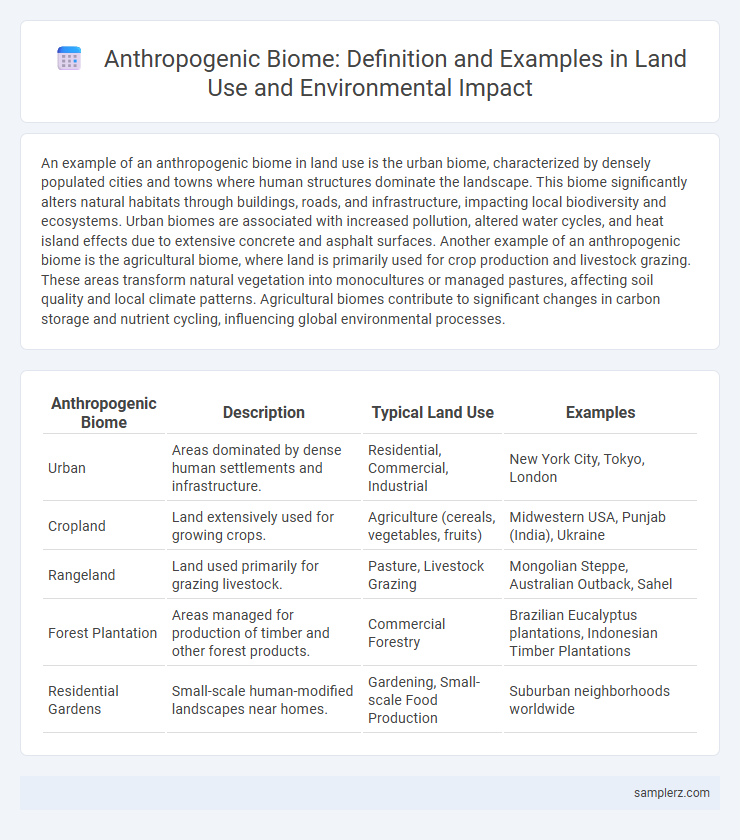An example of an anthropogenic biome in land use is the urban biome, characterized by densely populated cities and towns where human structures dominate the landscape. This biome significantly alters natural habitats through buildings, roads, and infrastructure, impacting local biodiversity and ecosystems. Urban biomes are associated with increased pollution, altered water cycles, and heat island effects due to extensive concrete and asphalt surfaces. Another example of an anthropogenic biome is the agricultural biome, where land is primarily used for crop production and livestock grazing. These areas transform natural vegetation into monocultures or managed pastures, affecting soil quality and local climate patterns. Agricultural biomes contribute to significant changes in carbon storage and nutrient cycling, influencing global environmental processes.
Table of Comparison
| Anthropogenic Biome | Description | Typical Land Use | Examples |
|---|---|---|---|
| Urban | Areas dominated by dense human settlements and infrastructure. | Residential, Commercial, Industrial | New York City, Tokyo, London |
| Cropland | Land extensively used for growing crops. | Agriculture (cereals, vegetables, fruits) | Midwestern USA, Punjab (India), Ukraine |
| Rangeland | Land used primarily for grazing livestock. | Pasture, Livestock Grazing | Mongolian Steppe, Australian Outback, Sahel |
| Forest Plantation | Areas managed for production of timber and other forest products. | Commercial Forestry | Brazilian Eucalyptus plantations, Indonesian Timber Plantations |
| Residential Gardens | Small-scale human-modified landscapes near homes. | Gardening, Small-scale Food Production | Suburban neighborhoods worldwide |
Introduction to Anthropogenic Biomes in Land Use
Anthropogenic biomes, or anthromes, represent landscapes significantly altered by human activities, such as urban areas, croplands, and managed forests. These modified biomes reflect human influence on land use patterns, biodiversity, and ecosystem functions. Examples include extensive agricultural lands that dominate regions like the Great Plains and urbanized zones impacting local climate and habitat connectivity.
Urban Settlements as Anthropogenic Biomes
Urban settlements represent a prominent anthropogenic biome characterized by high-density human populations, extensive infrastructure, and altered land surfaces. They significantly modify natural ecosystems through the replacement of vegetation with buildings, roads, and impervious surfaces, leading to habitat fragmentation and changes in local climate conditions. The concentration of human activity in these areas contributes to biodiversity loss, increased pollution, and challenges in sustainable resource management.
Croplands: Human-Altered Agricultural Landscapes
Croplands represent a significant anthropogenic biome characterized by human-altered agricultural landscapes optimized for large-scale food production. These areas often exhibit intensive land management practices, including irrigation, fertilization, and crop rotation, which transform natural ecosystems into highly productive agroecosystems. The extensive modification of soil and vegetation in croplands impacts biodiversity, carbon cycling, and local climate regulation, making them critical focal points in sustainable land use and environmental conservation efforts.
Pastoral Systems and Managed Grazing Lands
Pastoral systems and managed grazing lands represent key anthropogenic biomes characterized by human-controlled livestock grazing, primarily found in regions such as the Eurasian steppes, the Great Plains of North America, and the Sahel in Africa. These biomes play a crucial role in land use by supporting biodiversity and maintaining ecosystem services like soil fertility and carbon sequestration while sustaining pastoral livelihoods. Efficient management practices, including rotational grazing and stocking density regulation, mitigate environmental degradation and promote sustainable land use in these grazing-dominated landscapes.
Villages: Mixed Land Use and Human Habitation
Villages exemplify anthropogenic biomes characterized by mixed land use, combining residential areas, agricultural fields, and small-scale industry within a compact space. This integration supports human habitation while maintaining biodiversity through the coexistence of cultivated crops, livestock, and natural vegetation patches. The spatial arrangement in villages reflects adaptive land management strategies that balance ecological functions with socio-economic needs.
Industrial Landscapes and Their Environmental Impact
Industrial landscapes represent a prominent anthropogenic biome characterized by extensive land use for manufacturing, mining, and energy production. These areas often lead to significant environmental impact, including soil contamination, air and water pollution, and habitat fragmentation. Understanding the spatial distribution of industrial zones is crucial for developing sustainable land management practices and mitigating ecological degradation.
Plantation Forests as Managed Ecosystems
Plantation forests represent a significant anthropogenic biome characterized by monoculture tree crops grown for timber, pulp, and bioenergy production. These managed ecosystems alter native biodiversity and soil composition, often replacing natural forests or grasslands with fast-growing species like eucalyptus, pine, or acacia. Intensive management practices include fertilization, irrigation, and pest control, impacting carbon storage and local water cycles.
Suburban and Exurban Land Transformation
Suburban and exurban land transformation exemplifies an anthropogenic biome characterized by the expansion of low-density residential areas, leading to fragmented natural habitats and increased impervious surfaces. This land use change significantly alters local ecosystems by reducing biodiversity and disrupting native wildlife corridors. The conversion of agricultural or forested land into suburban developments contributes to increased carbon emissions and changes in hydrological cycles.
Transport Infrastructure and Habitat Modification
Transport infrastructure such as highways, railways, and airports significantly alter anthropogenic biomes by fragmenting natural habitats and modifying land use patterns. Urban development and road networks increase impermeable surfaces, leading to habitat loss and changes in local biodiversity. These modifications disrupt ecological connectivity and contribute to increased greenhouse gas emissions in terrestrial ecosystems.
Conservation Land and Human Influence on Natural Biomes
Conservation land represents a critical anthropogenic biome where human activities are directed towards preserving natural habitats and biodiversity, effectively mitigating land degradation and promoting ecosystem restoration. These areas often coexist with surrounding human-influenced biomes, reflecting a balance between conservation efforts and sustainable land use practices. The influence of conservation land on natural biomes is evident in the maintenance of ecological functions and the protection of species from the impacts of urbanization, agriculture, and industrial development.

example of anthropogenic biome in land use Infographic
 samplerz.com
samplerz.com